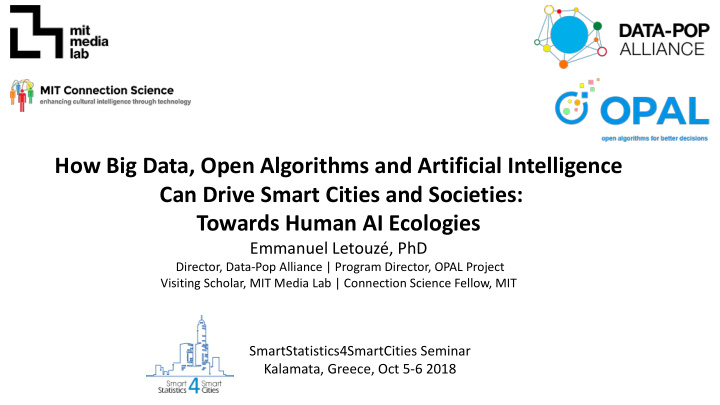



How Big Data, Open Algorithms and Artificial Intelligence Can Drive Smart Cities and Societies: Towards Human AI Ecologies Emmanuel Letouzé, PhD Director, Data-Pop Alliance | Program Director, OPAL Project Visiting Scholar, MIT Media Lab | Connection Science Fellow, MIT SmartStatistics4SmartCities Seminar Kalamata, Greece, Oct 5-6 2018
• Fake news. Biases. Automation. Echo chambers. Information overload. CO 2 emissions… • (Big) Data is getting a bad name. Are data, algorithms and AI threats to sustainable development and democracy? • Can we instead envision and build a world where Big Data, Open Algorithms and AI drive better, fairer, more sustainable and more resilient cities and societies? • Let’s call these ”Human Artificial Intelligence ” ecologies. What would it look like, and take?
How do(es) AI(s) Work? Is this a city or a beach? 1. Try to guess / recognize. Right or Wrong? 2. Correct: +1. Reward! 3. Incorrect: -1. Penalty! 4. Repeat and learn through many feedback loops. è (The) machine (is) learning
Big Data and AIs Hidden layer(s) Artificial intelligence is the simulation Input(s) Output(s) of human intelligence processes by computer systems, especially artificial neural networks (ANNs) inspired by the biological neural networks that constitute animal brains, which can "learn" (i.e. progressively improve performance on) through iterations and feedback. AIs are powered by algorithms that learn to automate parts or all of tasks, and the machines they power. (It’s also what has not been invented yet).
Is AI some new (black) magic? No…but… No… …but… 1. It is at least 60+ years old . 1. The (good) magic / core of the current AI is 2. It still generalizes poorly. It the credit assignment function to encourage has no sense of context. It and reinforce neurons / functions that help is still pretty stupid. the most achieve the goal (and reverse if not) 3. We are far from general AI . 2. The key difference and is data. Big Data. 4. Humans are still in control (for better or worse)
Some Early Applications Home to Clinics Commute in México Source: Noriega, Pentland
But: Power, Politics, Privacy. Who Has Access to Data, How, to Do What? Next: Implications. AND CULTURE Source: Letouzé, 2014 Source: Letouzé, 2013
Big Long Term Vision: Towards “Human AI” ecologies MIT Prof Alex ‘Sandy’ Pentland: “The big question that I'm asking myself these days is how can we make a human artificial intelligence? (…) I don't want to think small—people talk about robots and stuff—I want this to be global. (…) What would happen if you had a network of people where you could reinforce the ones that were helping and maybe discourage the ones that weren't? That begins to sound like a society or a company”. The Human Strategy. www.thehumanstrategy.mit.edu
Vision of a “Human AI” 1. Key principle 2. Key features 3. Key requirements • Good data on the system’s Leveraging human-machine functioning and performance Taking the key insights of AI complementarities : • Good feedback and especially humans do the strategy and • response systems (i.e. • role of data oversight and machines do the “human or society in the • credit assignment function tactics and bookkeeping loop”) reinforcing “neurons” that • Humans + Machines >> • Some general agreement on work (teams, groups, Humans or Machines inputs (facts) and outputs policies) through learning • New jobs will be created (e.g. (goals) machine prison guards but • Sufficient human skills and + applying this general more social workers) trust to oversee, implement. framework to entire societies • Resulting ecologies are more learn, adapt, and again agile and resilient
Main Challenges to a Human AI 1. Some powerful agents have strong incentives for this not to work (e.g. economic and political monopolies benefit from status quo) 2. Most societies / countries currently lack the appropriate data connections, capacities, and culture for this 3. There is widespread (and growing?) digital and analog segregation with distrust, disdain, echo chambers, alternative facts narratives, hampering cooperation and consensus building 4. We know AI can and has been used to nurture 3 . (cf Facebook newsfeed; Amazon Prime..)
“Open Algorithms”: A Bold New Vision and Project
OPAL: 1 st Generation Data Systems and Standards 2. Certified open algorithms developed by 1. Partner private developers are sent and run on the servers of companies (here a telecom partner private companies, behind their firewalls. operator) allow OPAL to access its servers through a secured platform. The data never leave the servers. 4. Key indicators derived from 3. A governance system including a Council private sector data such as for the Orientations of Development and population density, poverty Ethics (CODE) ensures that the algorithms levels, or mobility patterns, and use cases are ethically sound, context feed into use cases in various relevant, etc.; users benefit from capacity public policy and economic building activities domains. Data are safe, minimized, used (more) ethically.
OPAL Started with 2 pilots in Colombia and Senegal with 2 Major Telcos and their NSOs Founders Main funder Key partners
Key to all this: Building Capacities and Connections " Writing is a strange thing . If my hypothesis is correct, the primary function of writing, as a means of communication, is to facilitate the enslavement of other human beings ”. The fight against illiteracy goes on par with an increase in the control of the Power over citizens .” “We define data literacy as “literacy in the age of data”, i.e. “the desire and ability to constructively engage in society through or about data” .
Thank you eletouze@opalproject.org @mit.edu @datapopalliance.org
Recommend
More recommend